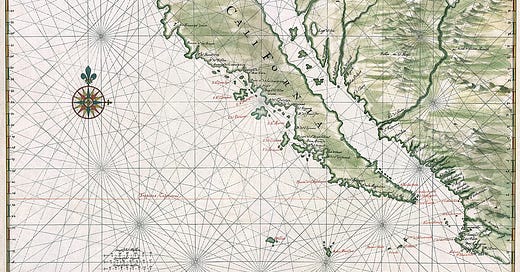Welcome to Cosmographia — a newsletter dedicated to exploring the world and our place in it. This post is part of our Terra Phantasma series, where we venture in search of the mysterious ‘phantom lands’ that have appeared on maps through the ages. For the full map of Cosmographia posts, see here.
In the early 1680s, the Venetian cosmographer Vincenzo Coronelli — perhaps the greatest ever globemaker — was commissioned by Louis XIV to build the largest globes then ever constructed.1 As was common practice at the time, he was to make two — one terrestrial, the other celestial.
The heavenly globe depicted the constellations of the night sky as they looked on the day of the Sun King’s birth, the signs of the Zodiac painted in ethereal shades of blue. The terrestrial sphere, on the other hand, was plainer in appearance, with the off-white continents decorated with small figures (showing all the prejudices of the time) and seas sailed by matchstick boats.
Eagled-eyed visitors to the Bibliothèque nationale de France, in Paris, where the globes are now housed, will notice on the western coast of North America Coronolli has repeated a common cartographical mistake of his time, alongside which he wrote:
Some crazy people say that California is a peninsula...
Garcia Rodríguez de Montalvo was born in Medina del Campo, Spain, in the middle of the 15th century. The Castilian grew up to become an accomplished writer, best remembered now for his translation and arrangement of the chivalric romance Amadís de Gaula — a book mentioned in the library of the eponymous knight in Don Quixote, but more famous for another fiction. The story follows the star-crossed love of King Perión of Gaula and Elisena of England, resulting in the secret love-child, Amadís, who was born in a mythical kingdom — a fitting detail, considering what happened next.
Not content to recount the traditional story, Montalvo added a fourth volume of his own making to the original three, and then wrote a sequel titled Las sergas de Esplandián. The last book, published in 1510, would leave a lasting mark on the world’s geography via the following passage:
Know that to the right of the Indies there is an island called California very close to the side of the Earthly Paradise; and its inhabitants were black women, without a single man, for they lived in the manner of the Amazons. They were beautiful and their bodies robust, with fiery courage and great strength. Their island is the most formidable in the world, with its steep cliffs and stony shores. Their weapons are all made of gold, as are the harnesses they use to tame their wild beasts, because there is no other metal on the island other than gold.
How Montalvo came to name his fictional island isn’t known for sure, but we might guess the warrior Queen Calafia, who ruled over its Amazonian inhabitants, might be a clue. It’s possible her name derives from the Arabic word khalifa — meaning ‘caliph’, or leader.
A second theory relates to the 11th-century epic poem, The Song of Roland, written to commemorate a battle fought (and lost) by Charlemagne in 778 AD. It reads:
Dead is my nephew, who conquered so much for me! Against me will rebel the Saxons, Hungarians, Bulgars, and many hostile men, Romans, Apulians, and all those of Palermo, And those of Africa, and those of Califerne...
The poem seems to indicate ‘Califerne’ as a geographical place, separate from Africa, presumably meaning ‘land of the caliph’. Given that, at the time of writing, the Spanish crown had only recently completed the Reconquista, thus ending Islamic rule in their last holdout on the Iberian Peninsula, perhaps its only natural that Montalvo would look to Arabic in his exoticisation of a fictional people.
Regardless of how the name came to be, the story caught the mood of the times — new ships were leaving Spanish ports bound for the New World every week — and quickly became a bestseller.







